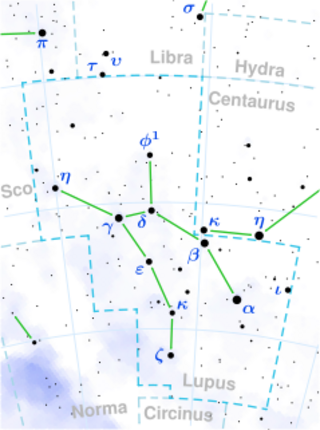Astronomy:Gliese 588
Coordinates: ![]() 15h 32m 12.93186s, −41° 16′ 32.1081″
15h 32m 12.93186s, −41° 16′ 32.1081″
| Observation data Equinox J2000.0]] (ICRS) | |
|---|---|
| Constellation | Lupus |
| Right ascension | 15h 32m 12.93186s[1] |
| Declination | −41° 16′ 32.1081″[1] |
| Apparent magnitude (V) | 9.311 |
| Characteristics | |
| Spectral type | M2.5V[2] |
| U−B color index | +1.14[3] |
| B−V color index | +1.51[3] |
| Astrometry | |
| Radial velocity (Rv) | 15.50 km/s |
| Proper motion (μ) | RA: -1176.447[4] mas/yr Dec.: -1030.9703[4] mas/yr |
| Parallax (π) | 168.9965 ± 0.0270[4] mas |
| Distance | 19.300 ± 0.003 ly (5.9173 ± 0.0009 pc) |
| Absolute magnitude (MV) | 10.44[5] |
| Details[6] | |
| Mass | 0.43±0.05 M☉ |
| Radius | 0.42±0.03 R☉ |
| Surface gravity (log g) | 4.82±0.08 cgs |
| Temperature | 3555±41 K |
| Metallicity [Fe/H] | 0.06±0.08 dex |
| Rotation | 61.3±6.5 d[7] |
| Other designations | |
| Database references | |
| SIMBAD | data |
Location of Gliese 588 in the constellation Lupus | |
Gliese 588 is a nearby red dwarf star of spectral type M2.5, located in the constellation Lupus at 19.34 light-years from Earth.[1] It emits a very stable light flux, with no detectable pulsations.[6]
History of observations
According to Luyten's (1979) (catalogue LHS, as well as NLTT), this object was discovered by Innes.[8][9] In 1903–1927 Innes was the director of the Union Observatory (UO), South Africa .
However, in the Ci 20 catalogue (see number 934) this star was designated as "CD -40 7021", not "UO".[10] This may indicate that GJ 588 was first catalogued earlier, in the Cordoba Durchmusterung by John M. Thome in 1894.[11][12] Note: the real CD designation of Gliese 588 is "CD-40 9712",[13] not "CD -40 7021":[10] GJ 588 has a RA of 15 hours, but the real CD -40 7021 has a RA of 11 hours.[14][11]
Planetary system
On 11 June 2019, two planets were detected by radial velocity around Gliese 588 among other 118 planets around M dwarf stars.[15]
| Companion (in order from star) |
Mass | Semimajor axis (AU) |
Orbital period (days) |
Eccentricity | Inclination | Radius |
|---|---|---|---|---|---|---|
| b (unconfirmed) | 2.4+1.0−0.9 M⊕ | 0.049±0.005 | 5.8084+0.0016−0.0018 | 0.04+0.25−0.04 | — | — |
| c (unconfirmed) | 10.3+6.9−4.9 M⊕ | 0.530+0.048−0.054 | 206.0+2.0−3.3 | 0.06+0.02−0.06 | — | — |
References
- ↑ 1.0 1.1 1.2 van Leeuwen, F. (2007). "Validation of the new Hipparcos reduction". Astronomy and Astrophysics 474 (2): 653–664. doi:10.1051/0004-6361:20078357. Bibcode: 2007A&A...474..653V. http://www.aanda.org/index.php?option=com_article&access=bibcode&Itemid=129&bibcode=2007A%2526A...474..653VFUL. Vizier catalog entry
- ↑ 2.0 2.1 "GJ 588". SIMBAD. Centre de données astronomiques de Strasbourg. http://simbad.u-strasbg.fr/simbad/sim-basic?Ident=GJ+588.
- ↑ 3.0 3.1 Mermilliod, J.-C. (1986). "Compilation of Eggen's UBV data, transformed to UBV (unpublished)". Catalogue of Eggen's UBV Data. Bibcode: 1986EgUBV........0M.
- ↑ 4.0 4.1 4.2 Brown, A. G. A. (2021). "Gaia Early Data Release 3: Summary of the contents and survey properties". Astronomy & Astrophysics 649: A1. doi:10.1051/0004-6361/202039657. Bibcode: 2021A&A...649A...1G. Gaia EDR3 record for this source at VizieR.
- ↑ "The One Hundred Nearest Star Systems". 2012. http://www.recons.org/TOP100.posted.htm.
- ↑ 6.0 6.1 Berdiñas, Z. M.; Rodríguez-López, C.; Amado, P. J.; Anglada-Escudé, G.; Barnes, J. R.; MacDonald, J.; Zechmeister, M.; Sarmiento, L. F. (2017), "High-cadence spectroscopy of M-dwarfs – II. Searching for stellar pulsations with HARPS", Monthly Notices of the Royal Astronomical Society 469 (4): 4268–4282, doi:10.1093/mnras/stx1140
- ↑ Suárez Mascareño, A.; Rebolo, R.; González Hernández, J. I.; Esposito, M. (2015), "Rotation periods of late-type dwarf stars from time series high-resolution spectroscopy of chromospheric indicators", Monthly Notices of the Royal Astronomical Society 452 (3): 2745–2756, doi:10.1093/mnras/stv1441, Bibcode: 2015MNRAS.452.2745S
- ↑ Luyten, Willem Jacob (1979). "LHS 397". LHS Catalogue, 2nd Edition. http://webviz.u-strasbg.fr/viz-bin/VizieR-5?-source=I/87B&LHS=397.
- ↑ Kirkpatrick, J. Davy; Gelino, Christopher R.; Cushing, Michael C.; Mace, Gregory N.; Griffith, Roger L.; Skrutskie, Michael F.; Marsh, Kenneth A.; Wright, Edward L. et al. (2012). "Further Defining Spectral Type "Y" and Exploring the Low-mass End of the Field Brown Dwarf Mass Function". The Astrophysical Journal 753 (2): 156. doi:10.1088/0004-637X/753/2/156. Bibcode: 2012ApJ...753..156K.
- ↑ 10.0 10.1 Porter, J. G.; Yowell, E. J.; Smith, E. S. (1930). "A catalogue of 1474 stars with proper motion exceeding four-tenths year.". Publications of the Cincinnati Observatory 20: 1–32. Bibcode: 1930PCinO..20....1P. Page 21 (Ci 20 934).
- ↑ 11.0 11.1 Thome, J. M. (1894). "Cordoba Durchmusterung declination -32 to -42.". Resultados del Observatorio Nacional Argentino 17: 1–538. Bibcode: 1894RNAO...17....1T. Page 468 (CD -40 9712); page 459 (CD -40 7021)
- ↑ Dictionary of Nomenclature of Celestial Objects. CD entry. SIMBAD. Centre de Données astronomiques de Strasbourg.
- ↑ Luyten, Willem Jacob (1979). "NLTT 40449". NLTT Catalogue. http://webviz.u-strasbg.fr/viz-bin/VizieR-5?-source=I/98A&recno=40449.
- ↑ Thome, John Macon (1892–1932). "CD -40 7021". Cordoba Durchmusterung. http://webviz.u-strasbg.fr/viz-bin/VizieR-5?-source=I/114&zone=-40&num=7021.
- ↑ Barnes, J. R.; Kiraga, M.; Diaz, M.; Berdiñas, Z.; Jenkins, J. S.; Keiser, S.; Thompson, I.; Crane, J. D.; Shectman, S. A. (2019-06-11). "Frequency of planets orbiting M dwarfs in the Solar neighbourhood". arXiv:1906.04644v1 [astro-ph.EP].
 |


